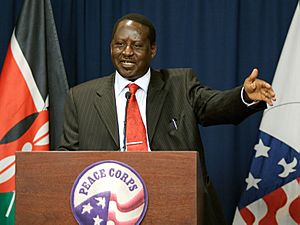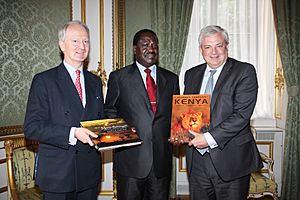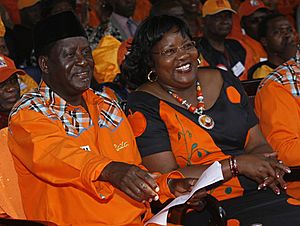Raila Odinga facts for kids
Quick facts for kids
Raila Odinga
|
|
|---|---|
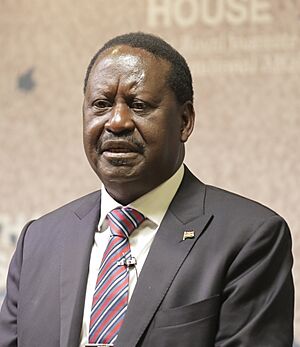
Odinga in 2017
|
|
| African Union High Representative for Infrastructure Development | |
| In office 20 October 2018 – 23 February 2023 |
|
| Chair | Moussa Faki |
| Preceded by | Elisabeth Tankeu (Commissioner of Trade and Industry) |
| 2nd Prime Minister of Kenya | |
| In office 17 April 2008 – 9 April 2013 |
|
| President | Mwai Kibaki |
| Deputy | Musalia Mudavadi Uhuru Kenyatta |
| Preceded by | Jomo Kenyatta (1964) |
| Succeeded by | Position abolished |
| Minister of Roads, Public Works and Housing | |
| In office 14 January 2003 – 21 November 2005 |
|
| President | Mwai Kibaki |
| Preceded by | William Cheruiyot Morogo |
| Succeeded by | Soita Shitanda |
| Minister for Energy | |
| In office 11 June 2001 – 30 December 2002 |
|
| President | Daniel arap Moi |
| Preceded by | Francis Masakhalia |
| Succeeded by | Simeon Nyachae |
| Member of Parliament for Langata Constituency | |
| In office 26 January 1993 – 28 March 2013 |
|
| Preceded by | Philip Leakey |
| Succeeded by | Joash Olum |
| Personal details | |
| Born |
Raila Amolo Odinga
7 January 1945 Maseno, Kenya Colony |
| Died | 15 October 2025. Koothattukulam, India |
| Political party | Forum for the Restoration of Democracy (before 1992) Forum for the Restoration of Democracy – Kenya (1992–1994) National Development Party (1994–2002) Kenya African National Union (2000–2002) Liberal Democratic Party (2002–2005) Orange Democratic Movement (2005–present) |
| Other political affiliations |
Coalition for Reforms and Democracy (2012–2017) National Super Alliance (2017–2021) Azimio la Umoja-One Kenya Coalition (2022–present) |
| Spouse |
Ida Odinga
(m. 1973) |
| Children | 4 (including Rosemary and Winnie Odinga) |
| Parent | Oginga Odinga (father) |
| Relatives | Oburu Odinga (brother) |
| Education | Otto von Guericke University Magdeburg |
| Signature | |
Raila Amolo Odinga (born 7 January 1945 – died 15 October 2025) was an important Kenyan politician. He served as the Prime Minister of Kenya from 2008 to 2013. He was also a Member of Parliament for the Langata Constituency from 1992 to 2013. After that, he became the Leader of Opposition in Kenya. He led the Azimio la Umoja–One Kenya Coalition Party.
Odinga tried to become President of Kenya five times. He did not win any of these elections. Each time, he claimed there were problems with how the votes were counted.
He ran for president in 1997, 2007, 2013, 2017, and 2022. In 2022, he was a candidate for Azimio la Umoja. After losing, he asked the Supreme Court of Kenya to review the election results. The court did not agree with him, and Odinga said he would accept their decision.
In February 2024, he announced he wanted to become the Chairperson for the African Union. However, he was not chosen for this role in February 2025. Odinga passed away on 15 October 2025, at the age of 80, in Koothattukulam, India.
Contents
- Early Life and School Days
- Starting His Career
- Journey into Politics
- Early Challenges and Detention
- Advocating for Multi-Party Democracy
- Serving as a Member of Parliament
- Forming Alliances and Cabinet Roles
- The National Rainbow Coalition
- Disagreements and New Movements
- The Orange Democratic Movement
- Working for Peace and Unity
- Representing the African Union
- Nicknames
- Presidential Campaigns
- His Ideas and Beliefs
- Personal Life
- His Passing
- Awards and Recognition
- See also
Early Life and School Days
Growing Up in Kenya
Raila Odinga was born on 7 January 1945, in Maseno, Kenya. His parents were Mary Juma Odinga and Jaramogi Oginga Odinga. His father was the first Vice President of Kenya. Raila is from the Luo community. He attended Kisumu Union Primary, Maranda Primary, and Maranda High School. In 1962, his father sent him to study in Germany.
Studying in Germany
He spent two years at the Herder Institution, learning German. This school was part of the University of Leipzig in East Germany. In 1965, he received a scholarship to study at the technical college in Magdeburg. This college is now part of Otto von Guericke University Magdeburg. He finished his studies in 1970 with a certificate in Welding. During his time in East Germany, he could visit West Berlin. He sometimes brought items from West Berlin to his friends in East Germany.
Starting His Career
Business Ventures
Odinga came back to Kenya in 1970. In 1971, he started a company called Standard Processing Equipment Construction & Erection Ltd. This company later became East African Spectre. It was the only company in Kenya that made cylinders for cooking gas.
Working for the Government
In 1974, Odinga began working for the Kenya Bureau of Standards. He was a group standards manager. Four years later, in 1978, he became the deputy director. He held this job until 1982.
Journey into Politics
Early Challenges and Detention
In 1982, there was an attempt to change the government in Kenya. Raila Odinga was accused of being involved. He was arrested and held without trial for six years. During this time, he was not allowed to see his family. He learned about his mother's death two months after it happened.
He was released in February 1988 but was arrested again later that year. This was because he spoke out for more democracy and fairness in the country. At that time, Kenya had only one political party. He was released in June 1989, but then arrested again in July 1990. He was finally set free in June 1991. After this, he went to Norway for a while.
Advocating for Multi-Party Democracy
When Odinga returned to Kenya in 1992, he joined the Forum for the Restoration of Democracy (FORD). This group wanted to bring back multi-party democracy to Kenya. He became the Vice Chairman of a committee within the party. FORD later split into two groups. Odinga became the Deputy Director of Elections for FORD-Kenya. He won the Langata Constituency parliamentary seat.
Serving as a Member of Parliament
After his father passed away in 1994, Odinga left FORD-Kenya. He then joined the National Development Party (NDP). In the 1997 General Election, he ran for president for the first time. He came in third place but kept his seat as the Langata MP.
Forming Alliances and Cabinet Roles
In a surprising move, Odinga decided to work with President Moi, who had been his political rival. His party, NDP, merged with Moi's KANU party. This new group was called New KANU. Odinga became the Energy Minister from 2001 to 2002. He was also elected as the party's Secretary General.
However, in 2002, President Moi chose Uhuru Kenyatta to be his successor. Odinga and other KANU members disagreed with this choice. They felt Uhuru was too new to politics. This disagreement led many members, including Odinga, to leave KANU.
The National Rainbow Coalition
The members who left KANU formed the Rainbow Movement. They joined with the Liberal Democratic Party (LDP). This group then teamed up with Mwai Kibaki's National Alliance Party of Kenya (NAK). Together, they created the National Rainbow Coalition (NARC).
Odinga supported Kibaki as the presidential candidate. He campaigned for Kibaki across the country. NARC won the election by a large margin, defeating Moi's chosen successor.
Disagreements and New Movements
After Kibaki became president, Odinga felt that a pre-election agreement was not fully honored. This agreement included making Odinga Prime Minister and giving his party more cabinet positions. Also, there was a disagreement about a new constitution. The proposed constitution seemed to give the president more power, which was different from what had been agreed upon.
Odinga campaigned against this new constitution in a national vote in 2005. The government lost this vote. Because of this, President Kibaki removed Odinga and his group from the cabinet.
The Orange Democratic Movement
After being removed from the cabinet, Odinga helped form a new opposition group. It was called the Orange Democratic Movement (ODM). The orange was the symbol for the "No" vote in the constitutional referendum.
Working for Peace and Unity
In 2017, Odinga lost the presidential election. He then held a ceremony where he declared himself the "People's President." A few months later, in March 2018, Odinga and President Uhuru Kenyatta met. They shook hands and agreed to work together for peace in Kenya. This event was called "the handshake."
This handshake led to the Building Bridges Initiative (BBI). Its goal was to collect ideas from Kenyans to bring peace and unity to the country. The team submitted its report in 2019. However, in 2022, the Supreme Court ruled that the BBI was unconstitutional.
Representing the African Union
In 2018, Odinga was appointed as the African Union High Representative for Infrastructure Development. He worked for the African Union Commission. He left this role on 23 February 2023.
Nicknames
Throughout his political career, Odinga earned several nicknames. These include "Tinga," "Hummer," "Baba," "Jakom," and "Agwambo."
Presidential Campaigns
The 2007 Election and Power-Sharing
In 2007, Odinga ran for president again. He was the candidate for the Orange Democratic Movement (ODM). The election results were disputed, and there was unrest in the country. After two months, a deal was made between Odinga and President Kibaki. This deal created a power-sharing government and brought back the position of Prime Minister. Odinga was sworn in as Prime Minister on 17 April 2008. He was the second person in Kenya's history to hold this position.
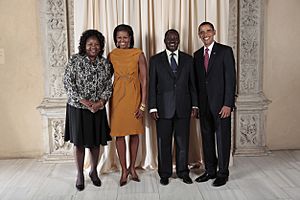
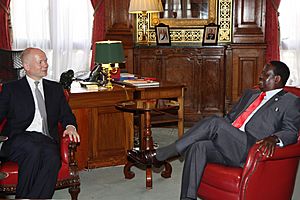
The 2013 Election Challenge
Odinga ran for president in the March 2013 election. His party, ODM, joined with other parties to form the CORD coalition. He faced candidates Uhuru Kenyatta and William Ruto.
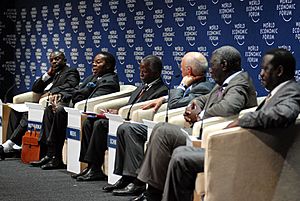
Uhuru Kenyatta won the election in the first round. Odinga claimed there were many problems with the election technology. He challenged the results in Kenya's Supreme Court. The Supreme Court dismissed his challenge on 30 March 2013. Odinga did not attend Uhuru Kenyatta's inauguration, which marked the end of his time as Prime Minister.
The 2017 Election and Court Ruling
In the 2017 presidential elections, Odinga claimed that the election system had been hacked. He said that the results were manipulated to favor his opponent, Uhuru Kenyatta. He demanded to be declared the winner.
The election body, IEBC, announced Uhuru Kenyatta as the winner. Odinga's team refused to accept these results. After some initial hesitation, Odinga took his case to the Supreme Court. On 1 September, the court made a historic decision. It annulled the presidential results and ordered a new election within 60 days. The court said the election was not conducted properly.
Odinga later announced he would not participate in the new election. He believed the election would not be fair without reforms. The IEBC stated his name would still appear on the ballot. There was some unrest in parts of the country before and after the repeat election.
On 30 January, Odinga held a ceremony where he named himself 'People's President'. A month later, he and President Uhuru Kenyatta appeared together. They agreed to set aside their political differences for Kenya's future.
The 2022 Election Attempt
On 10 December 2021, Odinga announced his fifth bid for the presidency. He launched his campaign with the Azimio La Umoja–One Kenya Coalition party. He was cleared to run by the IEBC on 5 June 2022. Martha Karua was his running mate.
On 6 June, Odinga presented his 10-point plan for Kenya. This plan included ideas for social protection, healthcare, job creation, and education. He ran against William Ruto. Ruto won the election with 50.5% of the votes. Odinga challenged the result in the Supreme Court, but his case was dismissed. Many saw this as his last chance to become president.
His Ideas and Beliefs
Odinga's political ideas are similar to social democracy. He believed in a system where power is shared with local governments. This idea, called devolution, is now part of Kenya's constitution. It aims to ensure all regions receive fair resources, regardless of their politics or ethnicity.
He also supported helping people in need. He called for removing taxes on fuels and certain foods to help poor families. He also supported cash-transfer programs for low-income people.
Personal Life
Raila Odinga was baptized as an Anglican Christian when he was a child. Later, he became a Born-Again Christian. He was a member of All Saints' Cathedral in Nairobi.
Odinga was married to Ida Odinga (Ida Anyango Oyoo) in 1973. They had four children: Fidel (1973–2015), Rosemary (born 1977), Raila Jr. (born 1979), and Winnie (born 1990). Winnie is currently studying at Drexel University in Philadelphia. She is also a representative in the East Africa Legislative Assembly (EALA).
Odinga briefly played soccer as a midfielder for Luo Union, which is now Gor Mahia. He was also a fan of the English football club Arsenal.
In 2010, the African Union asked Odinga to help resolve a political crisis in Ivory Coast. He wrote a 1040-page autobiography called "Flame of Freedom." It was launched in Kenya and the United States in 2013.
His Passing
Odinga passed away on 15 October 2025. He suffered a cardiac arrest while seeking medical treatment at an Ayurvedic hospital in Koothattukulam, India. He was 80 years old.
Awards and Recognition
Honorary Degrees
| University | Country | Honour | Year |
|---|---|---|---|
| University of Nairobi | Kenya | Doctor of Laws | 2008 |
| Florida A&M University | United States | Honorary degree | 2012 |
| Limkokwing University of Creative Technology | Malaysia | Doctorate of Leadership in Social Development | 2012 |
See also
 In Spanish: Raila Odinga para niños
In Spanish: Raila Odinga para niños



